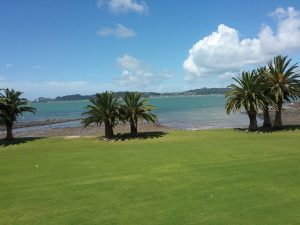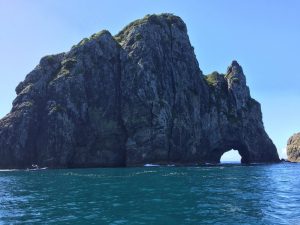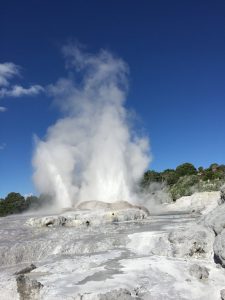We are now well into our tour of New Zealand, and sorry Sydney, but you have a rival for my affections. Mr T and I have never done a coach tour before, mainly because (a) we’ve never felt old enough and (b) we are usually very happy to potter about under our own steam. However, as we are doing our own thing for 4 weeks in Australia, when it came to planning what to see and what to miss in New Zealand – with tropical rain forests in the north, and fjords and glaciers in the south – we decided to let somebody else take the strain of choosing our route. I have to admit we may well be youngest in our tour group, but it’s not many a non-retiree who can afford to take the time off work and a trip to the Antipodes needs time, as we are rapidly finding out!
So, who has stolen my heart? The Bay of Islands and in particular the small town of Paihia, approximately 300 km north of Auckland. I dont need cities with glistening white skyscraper skylines, I’m a country girl at heart. Give me green spaces (and NZ has an awful lot of them) a sweeping coastline, and I’m happy. Add in dozens of islands dotted across the bay, palm trees, sand, dolphins, and I’m in heaven. We had a room with a view, and what a stunning view it was. We had apparently been bumped up from the usual ‘garden rooms’ at our hotel by the prime minister’s entourage. Thirty-seven year old Jacinda Adhearn (take note UK – young, woman, prime minister) was in Paihia along with several hundred Māori for the Waitaingi Day celebrations – the annual commemoration of the signing of the original treaty between the Maori population and the British and a national holiday in New Zealand. Pahia is a beautiful place, with an old fashioned ‘au naturale’ unpretentious, charm.
It was almost sad to leave, but leave we had to, because we had a lot of kilometres to cover and a lot more sightseeing to fit in. After another brief pit-stop in Auckland, the City of Sails and home to almost a quarter of New Zealand’s total population, we headed for Rotorua. Rotorua is famous for its geo-thermal hot springs. When you are travelling with limited resources sometimes you have to improvise; in Paihia hairspray had been used to stupify a couple of rogue mosquitoes into a firm hold; in Rotorua, body spray doubled up as air freshener in an attempt to disguise the pungent aroma of sulphur that permeates the town and infiltrated our hotel room. At the thermal village of Te Puia, Rotorua’s largest geyser Pohutu performed right on cue, sending up a steamy spout 30 m into the air. Sadly, the reserve’s population of endangered kiwis were not quite so forthcoming. Kiwis are nocturnal, and also very shy. We had to make do with a stuffed model during a talk by a kiwi conservation expert.
We couldn’t leave Rotorua without testing the medicinal properties of its thermal spa waters for ourselves. They always say good things come to those who wait and we have waited a long time to make this trip. We arrived at the Polynesian Spa (one of the top ten spas in the world according to Conde Nest) to be told by the receptionist that a two people who had been unable to take up their pre-booked session had donated their ticket to the next ‘suitable’ couple. I’d never felt more suitable in my life! There were five pools available to us in our much appreciated complimentary deluxe spa package, all overlooking the calcified and somewhat eerie banks of Lake Rorotua. We hopped from the anti-aging properties of Rachel’s Spring water to the anti-rheumatic delights of the Priest’s Pool. I suppose only time will tell whether the magic of the natural springs will work!
The downside of an organised tour is of course sometimes you are organised into doing things you wouldn’t always choose to do. I could have lived without the sheep shearing show, fun though it was, but on the whole, so far things are turning out well.
And as for Rorotua, it might well be something of a tourist trap but there’s plenty to see and do. It’s just a question of getting used to that smell.


